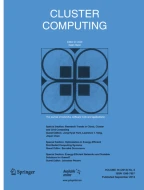Abstract
The Network Weather Service is a generalizable and extensible facility designed to provide dynamic resource performance forecasts in metacomputing environments. In this paper, we outline its design and detail the predictive performance of the forecasts it generates. While the forecasting methods are general, we focus on their ability to predict the TCP/IP end-to-end throughput and latency that is attainable by an application using systems located at different sites. Such network forecasts are needed both to support scheduling (Berman et al., 1996) and, by the metacomputing software infrastructure, to develop quality-of-service guarantees (DeFanti et al., to appear; Grimshaw et al., 1994).
Similar content being viewed by others
References
AppLeS, http://www-cse.ucsd.edu/groups/hpcl/apples/apples.html.
S. Basu, A. Mukherjee and S. Kilvansky, Time series models for Internet traffic, Technical Report GIT-CC-95-27, Georgia Institute of Technology (1996).
F. Berman and R. Wolski, Scheduling from the perspective of the application, in: Proceedings of High-Performance Distributed Computing Conference(1996).
F. Berman, R. Wolski, S. Figueira, J. Schopf and G. Shao, Application level scheduling on distributed heterogeneous networks, in: Proceedings of Supercomputing' 96(1996).
J. Burg, Maximum entropy spectral analysis, Ph.D. thesis, Stanford University (1975).
R. Carter and M. Crovella, Dynamic server selection using bandwidth probing in wide-area networks, Technical Report TR-96-007, Boston University (1996).
M. Crovella and A. Bestavros, Self-similarity in world wide web traffic: Evidence and possible causes, in: Proceedings of the 1996 ACM Sigmetrics Conference on Measurement and Modeling of Computer Systems(1996).
M. Crovella and T. LeBlanc, Parallel performance prediction using lost-cycles analysis, in: Proceedings of Supercomputing' 94(1994).
T. DeFanti, I. Foster, M. Papka, R. Stevens and T. Kuhfuss, Overview of the i-way: Wide area visual supercomputing, International Journal of Supercomputer Applications (to appear).
T. DeFanti, I. Foster, M. Papka, R. Stevens and T. Kuhfuss, Overview of the i-way: Wide area visual supercomputing, International Journal of Supercomputer Applications (to appear).
Distributed object computation testbed, http://www.sdsc.edu/DOCT/QuadPage.html.
N. Gallagher and G. Wise, A theoretical analysis of the properties of median filters, IEEE Transactions ASSP (December 1981).
R. Gallant and G. Tauchen, Snp: A program for nonparametric time series analysis, http://www.econ.duke.edu/Papers/Abstracts/abstract.95.26.html.
R. Gallant and G. Tauchen, Seminonparametric estimation of conditionally constrained heterogeneous processes: Asset pricing applications, Econometrica 57 (1989) 1091-1120.
Globus, http://www.mcs.anl.gov/globus.
C. Granger and P. Newbold, Forecasting Economic Time Series(Academic Press, 1986).
A.S. Grimshaw, W.A. Wulf, J.C. French, A.C. Weaver and P.F. Reynolds, Legion: The next logical step toward a nationwide virtual computer, Technical Report CS-94-21, University of Virginia (1994).
N. Groschwitz and G. Polyzos, A time series model of long-term traffic on the nsfnet backbone. in: Proceedings of the IEEE International Conference on Communications(ICC' 94) (May 1994).
R. Haddad and T. Parsons, Digital Signal Processing: Theory, Applications, and Hardware(Computer Science Press, 1991).
M. Harchol-Balter and A. Downey, Exploiting process lifetime distributions for dynamic load balancing, in: Proceedings of the 1996 ACM Sigmetrics Conference on Measurement and Modeling of Computer Systems(1996).
J. Hollingsworth, B. Miller and J. Cargille, Dynamic program instrumentation for scalable performance tools, in: Proceedings of SHPCC' 94(1994).
V. Jacobson, Congestion avoidance and control, in: Proceedings of SIGCOMM' 88, Vol. 18 (August 1988).
S. Keshav, A control-theoretic approach to flow control, in: Proceedings of SIGCOMM' 91, Vol. 24 (August 1991).
H. Korab and M. Brown, Virtual environments and distributed computing at sc'95: Gii testbed and hpc challenge applications on the i-way, in: Proceedings of Supercomputing' 95(1995).
Legion, http://www.cs.virginia.edu/mentat/legion/legion.html.
W.E.A. Leland, On the self-similar nature of Ethernet traffic, IEEE/ACM Transactions on Networking (February 1994).
L. Ljung and T. Soderstrom, Theory and Practice of Recursive Identification(MIT Press, 1983).
A. Malony, D. Reed and H. Wijshoff, Performance measurement intrusion and perturbation analysis, IEEE-TPDS 3(4) (July 1992) 433-450. Available as Technical Report CSRD-923, University of Illinois, Center for Supercomputing Research and Development. Reprinted in Monitoring and Debugging Distributed and/or Real-Time Systems, eds. J. Tsai and S. Yang (IEEE CS Press, (1995) pp. 77-94.
Netperf, http://www.cup.hp.com/netperf/netperfpage.html.
P.E.A. Postel, Transmission control protocol specification, RFC-793, ARPA Working Group Requests for Comment DDN Network Information Center, SRI International, Menlo Park, CA (1981).
vBNS, http://www.vbns.net.
Author information
Authors and Affiliations
Rights and permissions
About this article
Cite this article
Wolski, R. Dynamically forecasting network performance using the Network Weather Service. Cluster Computing 1, 119–132 (1998). https://doi.org/10.1023/A:1019025230054
Issue Date:
DOI: https://doi.org/10.1023/A:1019025230054
